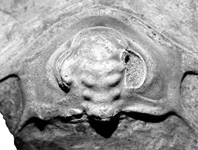Abstract
The olenelloid trilobite genus Laudonia Harrington, 1956 was thought to occur widely along the Cordilleran margin of Laurentia in lowermost Dyeran strata (Cambrian Series 2). However, supposed occurrences in the Rosella Formation (Cassiar Mountains, northern British Columbia), the Mural Formation (Cariboo Mountains, east-central British Columbia) and the Poleta Formation (Nevada)—re-examined, morphometrically analyzed, and fully documented for the first time herein—are found to actually represent occurrences of species of Lochmanolenellus Lieberman, 1998. This revision results in the restriction of Laudonia to two species—Laudonia bispinata Harrington, 1956 and Laudonia amputata Fritz, 1992—that are known only from the Mural Formation of the Mount Robson area (Canadian Rocky Mountains, Alberta/British Columbia) and are therefore of little biostratigraphic utility. Conversely, taxonomic and morphological diversity within the formerly monotypic Lochmanolenellus is greatly expanded by the description of three new species plus several in open nomenclature. The new species form a stratigraphic succession comprising Lochmanolenellus pentagonalis n. sp. (oldest) followed by Lochmanolenellus subquadratus n. sp. and then Lochmanolenellus trapezoidalis n. sp. (youngest) in the Cassiar Mountains and in Nevada, and thus seem to offer some biostratigraphic utility. Lochmanolenellus primus (Lochman in Cooper et al., 1952), the genotype, occurs only in the Puerto Blanco Formation (Caborca area, Sonora). These new data, combined with a comparative study of the ontogenetic development of the cephalon of each of the new species of Lochmanolenellus to other olenelloids, strongly suggest that Lochmanolenellus is closely related to “wanneriid” olenelloids such as Wanneria Walcott, 1910 and Elliptocephala Emmons, 1844 rather than to biceratopsid olenelloids.

